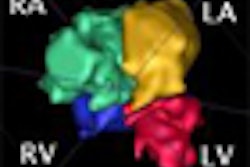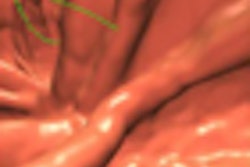Sunday, November 29 | 12:30 p.m.-1:30 p.m. | LL-VI4353-B07 | Lakeside Learning Center
A semiautomated segmentation software approach can track the volume of abdominal aortic aneurysms (AAA), a method more than twice as sensitive as traditional maximal diameter measurements, according to research to be presented on Sunday.Believing that the maximal diameter (D-max) predictor of AAA rupture risk was too simplistic to describe the complex 3D geometries of AAA, the researchers were convinced that 3D models were required to properly characterize AAA morphology, measure thrombus and lumen volume, track growth measurements between follow-up studies, and predict rupture risk, said Claude Kauffmann, Ph.D., of Hôpital Notre-Dame, Centre Hospitalier de l'Université de Montréal (CHUM).
The group developed software that provides:
- Identification of AAA lumen entry and exit points and automatic lumen segmentation
- Interactive aneurysm wall segmentation on curved multiplanar reformatted (MPR) images based on active contour models
- 3D reconstruction of the wall, thrombus, and lumen
- Automated calculation of D-max and volumes of the AAA components
To test their technique, the CHUM researchers performed a retrospective study of 34 patients, comparing their baseline and follow-up CT angiography studies between 2004 and 2009.
The studies were first segmented twice by one senior vascular radiologist and then once by three nonsupervised technologists. All four participants were asked to segment the 68 AAA studies.
Using the radiologist as the gold standard, the results were compared for D-max and volume. The researchers found that volume measurements were more than twice as sensitive as the D-max measurements, with equivalent reproducibility. Segmentation took an average of three minutes.
Kauffmann said the technique may also help provide early detection of endoleak during stent-graft follow-up.
"Our methods for displaying the D-max and volume results have been greeted with interest by the clinicians and radiologists involved in our study," he told AuntMinnie.com.




















